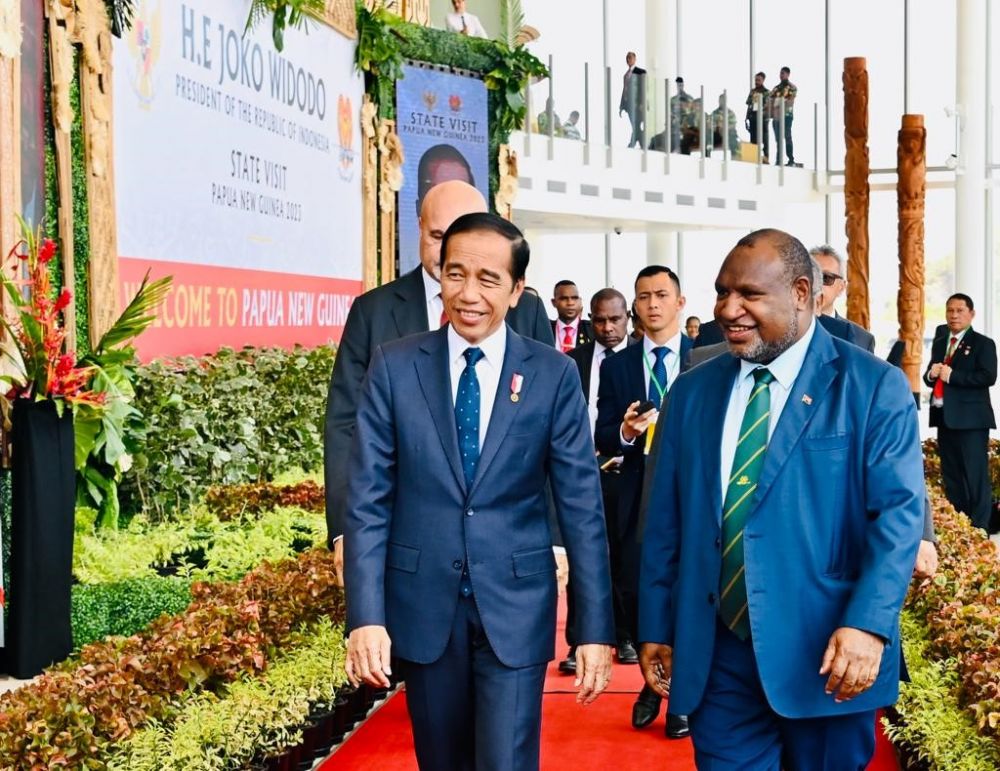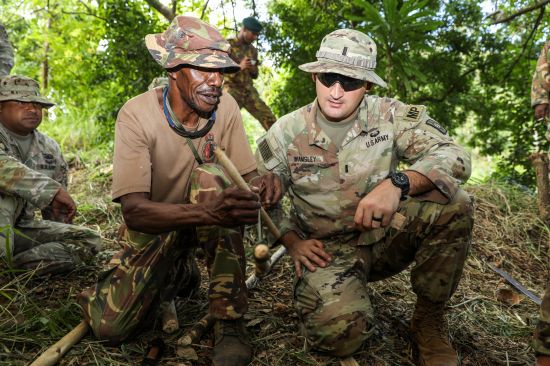Countries in Southeast Asia and the Pacific have common interests and challenges. Aristyo Rizka Darmawan of the Australian National University and the University of Indonesia examines ASEAN chair Indonesia’s recent efforts to bring the two regions closer together.
Reaching out across the Indo-Pacific: Indonesian President Jokowi is welcomed by Prime Minister of Papua New Guinea James Marape in Port Moresby, July 5 (Credit: Cabinet Secretariat of the Republic of Indonesia)
In July, Indonesia hosted the Association of Southeast Asian Nations (ASEAN) Ministerial Meeting in Jakarta. On the first day of the conference, foreign ministers concluded agreements on ASEAN external relations. Among the points of accord was a decision to initiate inter-secretariat cooperation between ASEAN and the Pacific Islands Forum (PIF). The ministers also adopted a concept note on ASEAN-PIF cooperation. This effort to bring Southeast Asia and the Pacific Island countries (PICs) closer is important for the interests of Indonesia and, more broadly, of ASEAN and the Indo-Pacific region.
Earlier, Indonesian President Joko Widodo (known as Jokowi) made a state visit to Papua New Guinea, during which he underscored the importance for ASEAN to have closer relationships and cooperation with Pacific Island countries. Indeed, in the past few years, Indonesia has reiterated its commitment to closer relations with the PICs. Jakarta aims to do this through the Indonesia-Pacific Forum for Development (IPFD), a gathering convened in December 2022 that built on previous interaction between Indonesia and countries in the South Pacific. As Indonesian Foreign Minister Retno Marsudi has said, Indonesia and the PICs share the goals of common security and prosperity.
Why is it important for Indonesia to push ASEAN to have a closer relationship with the PICs through the PIF?
First, there is the geopolitics. With the dynamics of the United States and China rivalry in the Indo-Pacific, Indonesia is concerned that the region should not become a battleground for a proxy war in the competition between the great powers. ASEAN has asserted its neutrality and centrality amid the global contest through the ASEAN Outlook on the Indo-Pacific (AOIP), released in 2020. Even though some ASEAN countries might prefer to lean one way or the other in balancing their relationships with the US and China, ASEAN as a group has reiterated its commitment to remaining neutral.
As it does so, ASEAN should project its ideals and principles – including the idea of neutrality – beyond the region and across the Indo-Pacific. It is, therefore, important for ASEAN to have closer relations with the PICs. Both ASEAN and the PIF (which was founded in 1971 and includes 18 members) are both key regional organizations in the Indo-Pacific which can be critical platforms for cross-regional cooperation Australia and New Zealand, both part of the PIF, are dialogue partners of ASEAN.
With a stronger relationship between ASEAN and the PICs through the PIF, ASEAN can promote its neutral, peaceful and inclusive approach to the Indo-Pacific region. The concern in Indonesia and other ASEAN member states is that, if the US-China competition in the Pacific heats up, it will have spillover effects in Southeast Asia – and vice-versa. Both regions have an interest in maintaining collective neutrality, even if certain members exhibit a preference.
The second major motivation for closer ASEAN-Pacific relations is their common concern about climate change. As maritime regions with archipelagic and island countries, Southeast Asia and the Pacific face an existential threat of climate change. Mounting problems such as the sea-level rise, ocean acidification and plastics pollution will have an impact on the livelihoods of their people. Closer ties between the two regions can spur collaboration in dealing with global warming and related issues and to help their countries achieve their net-zero greenhouse gas targets. They could cooperate in the restoration and planting of mangrove forests, which are prevalent in both regions and critical to addressing carbon emissions. In June, Indonesia hosted ASEAN and PIF members at a workshop in Bali on managing marine plastic debris. Participants hoped to be able to share knowledge and best practices in dealing with plastic waste.
Climate change should be the core of the budding cooperation between ASEAN and the Pacific and become the foundation for a broader partnership. This would enhance the capacity of both regions each as a group to navigate the geopolitical crosscurrents that are expected to roil the Indo-Pacific for the foreseeable future.
Further reading:
Check out here for more research and analysis from Asian perspectives.

